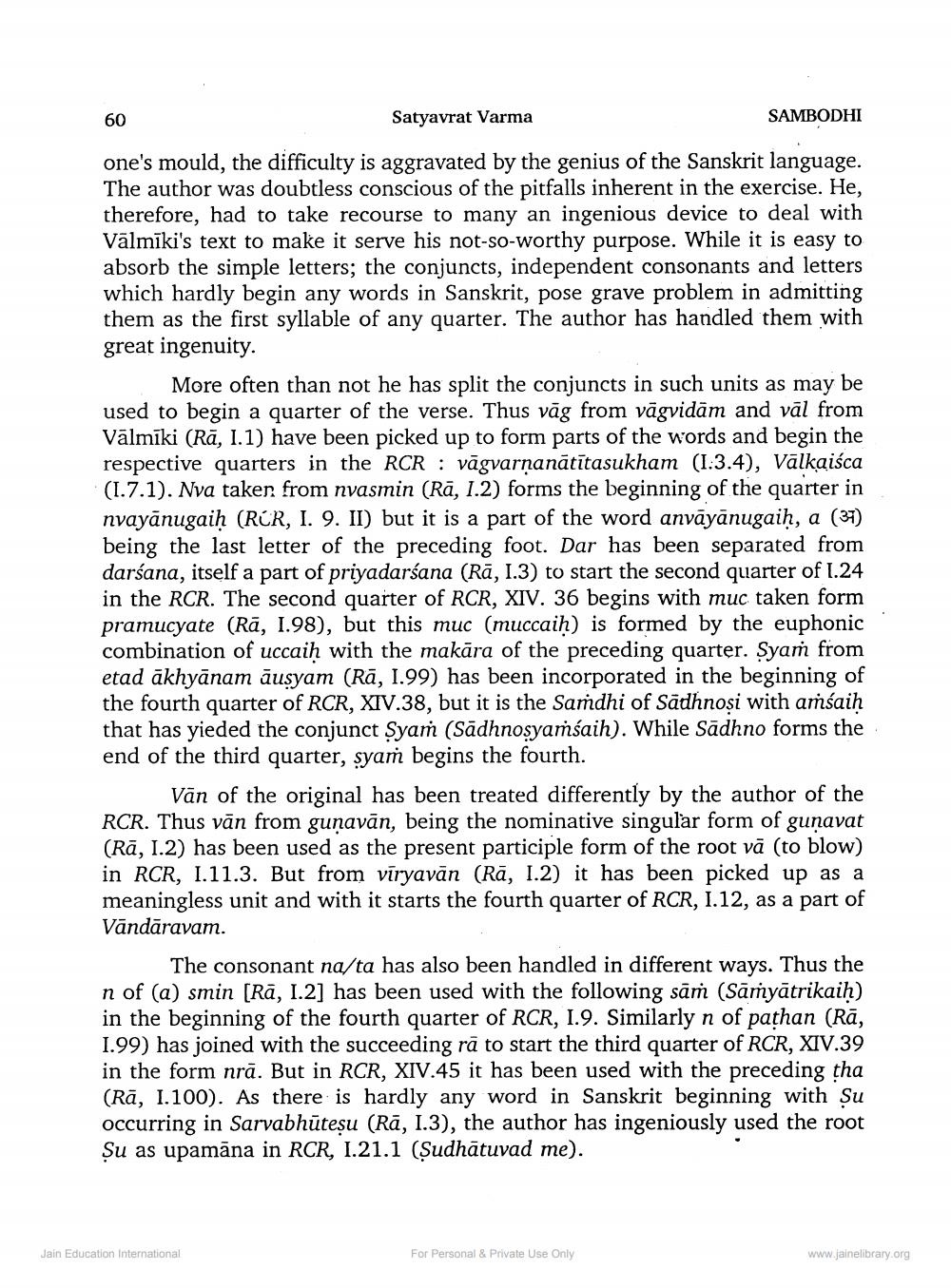________________
60
Satyavrat Varma
SAMBODHI
one's mould, the difficulty is aggravated by the genius of the Sanskrit language. The author was doubtless conscious of the pitfalls inherent in the exercise. He, therefore, had to take recourse to many an ingenious device to deal with Vālmīki's text to make it serve his not-so-worthy purpose. While it is easy to absorb the simple letters; the conjuncts, independent consonants and letters which hardly begin any words in Sanskrit, pose grave problem in admitting them as the first syllable of any quarter. The author has handled them with great ingenuity.
More often than not he has split the conjuncts in such units as may be used to begin a quarter of the verse. Thus vāg from vāgvidām and vāl from Vālmīki (Rā, I.1) have been picked up to form parts of the words and begin the respective quarters in the RCR : vāgvarṇanātītasukham (1.3.4), Vālkaiśca (I.7.1). Nva taken from nvasmin (Rā, I.2) forms the beginning of the quarter in nvayānugaiḥ (RÚR, I. 9. II) but it is a part of the word anvāyānugaiḥ, a (37) being the last letter of the preceding foot. Dar has been separated from darśana, itself a part of priyadarśana (Rā, I.3) to start the second quarter of 1.24 in the RCR. The second quarter of RCR, XIV. 36 begins with muc taken form pramucyate (Rā, 1.98), but this muc (muccaiḥ) is formed by the euphonic combination of ucсaih with the makāra of the preceding quarter. Syaṁ from etad ākhyānam āusyam (Rā, 1.99) has been incorporated in the beginning of the fourth quarter of RCR, XIV.38, but it is the Samdhi of Sadhnosi with aṁsaih that has yieded the conjunct Syam (sādhnosyamsaih). While Sādhno forms the end of the third quarter, syam begins the fourth.
Vān of the original has been treated differently by the author of the RCR. Thus vān from gunavān, being the nominative singular form of gunavat (Rā, I.2) has been used as the present participle form of the root vā (to blow) in RCR, 1.11.3. But from vīryavān (Rā, I.2) it has been picked up as a meaningless unit and with it starts the fourth quarter of RCR, 1.12, as a part of Vāndāravam.
The consonant na/ta has also been handled in different ways. Thus the n of (a) smin (Rā, 1.2] has been used with the following sāṁ (Samyātrikaih) in the beginning of the fourth quarter of RCR, 1.9. Similarly n of pathan (Rā, 1.99) has joined with the succeeding rā to start the third quarter of RCR, XIV.39 in the form nrā. But in RCR, XIV.45 it has been used with the preceding tha (Rā, 1.100). As there is hardly any word in Sanskrit beginning with Su occurring in Sarvabhūtesu (Rā, I.3), the author has ingeniously used the root Şu as upamāna in RCR, 1.21.1 (Sudhātuvad me).
Jain Education International
For Personal & Private Use Only
www.jainelibrary.org




